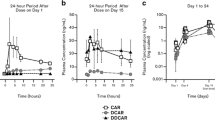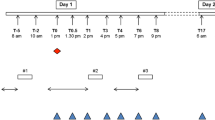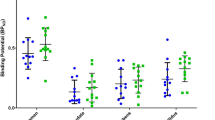Abstract
Rationale
The D1-like dopamine receptors have been suggested to play a role in the pathophysiology and treatment of schizophrenia. Previous positron emission tomography studies have demonstrated that the atypical antipsychotic clozapine occupies D1-like dopamine receptors in the striatum in clozapine-treated patients.
Objectives
The aim of the present study was to compare striatal and cortical D1-like dopamine receptor occupancy by clozapine in the primate brain.
Methods
Three monkeys were each examined three times at the same day with the radioligand (+)−[11C]NNC 112. The first measurement was at baseline conditions, the second after 1.5 mg/kg and the third after 6 mg/kg clozapine IV. To compare regional levels of nonspecific binding in brain regions, an additional monkey was examined using the inactive enantiomer (−)−[11C]NNC 112. Receptor occupancy was calculated using both the equilibrium–ratio analysis and the simplified reference tissue model.
Results
After 1.5 mg/kg the D1-like dopamine receptor occupancy ranged from 30 to 38% in the striatum, whereas the range was 51 to 57% in the frontal cortex. After 6.0 mg/kg the occupancy was 53 to 64% in the striatum and 63 to 83% in the frontal cortex. The differences between striatal and cortical D1-like receptors occupancy were between 12 and 25%. The study with (−)−[11C]NNC 112 did not show regional differences in nonspecific binding that might explain the regional differences in occupancy.
Conclusions
The higher D1-like dopamine receptor occupancy in the frontal cortex may reflect a different distribution of the D1 and D5 dopamine receptor subtypes among brain regions and different affinity of clozapine for the two subtypes. The finding supports the suggestion that binding to D1-like dopamine receptors may explain clozapine’s atypical drug actions.




Similar content being viewed by others
References
Abi-Dargham A, Simpson N, Kegeles L, Parsey R, Hwang DR, Anjilvel S, Zea-Ponce Y, Lombardo I, Van Heertum R, Mann JJ, Foged C, Halldin C, Laruelle M (1999) PET studies of binding competition between endogenous dopamine and the D1 radiotracer [11C]NNC 756. Synapse 32:93–109
Abi-Dargham A, Mawlawi O, Lombardo I, Gil R, Martinez D, Huang Y, Hwang DR, Keilp J, Kochan L, Van Heertum R, Gorman JM, Laruelle M (2002) Prefrontal dopamine D1 receptors and working memory in schizophrenia. J Neurosci 22:3708–3719
Ahlenius S (1999) Clozapine: dopamine D1 receptor agonism in the prefrontal cortex as the code to decipher a Rosetta stone of antipsychotic drugs. Pharmacol Toxicol 84:193–196
Baldessarini RJ, Frankenburg FR (1991) Clozapine. A novel antipsychotic agent. N Engl J Med 324:746–754
Chou YH, Karlsson P, Halldin C, Olsson H, Farde L (1999) A PET study of D(1)-like dopamine receptor ligand binding during altered endogenous dopamine levels in the primate brain. Psychopharmacology 146:220–227
Chou YH, Halldin C, Farde L (2000) Effect of amphetamine on extrastriatal D2 dopamine receptor binding in the primate brain: a PET study. Synapse 38:138–143
Farde L, Hall H, Ehrin E, Sedvall G (1986) Quantitative analysis of D2 dopamine receptor binding in the living human brain by PET. Science 231:258–261
Farde L, Pauli S, Hall H, Eriksson L, Halldin C, Hogberg T, Nilsson L, Sjogren I, Stone-Elander S (1988) Stereoselective binding of 11C-raclopride in living human brain—a search for extrastriatal central D2-dopamine receptors by PET. Psychopharmacology 94:471–478
Farde L, Eriksson L, Blomquist G, Halldin C (1989a) Kinetic analysis of central [11C]raclopride binding to D2-dopamine receptors studied by PET—a comparison to the equilibrium analysis. J Cereb Blood Flow Metab 9:696–708
Farde L, Wiesel FA, Nordstrom AL, Sedvall G (1989b) D1- and D2-dopamine receptor occupancy during treatment with conventional and atypical neuroleptics. Psychopharmacology 99:S28–S31
Farde L, Nordstrom AL, Wiesel FA, Pauli S, Halldin C, Sedvall G (1992) Positron emission tomographic analysis of central D1 and D2 dopamine receptor occupancy in patients treated with classical neuroleptics and clozapine. Relation to extrapyramidal side effects. Arch Gen Psychiatry 49:538–544
Farde L, Ginovart N, Ito H, Lundkvist C, Pike VW, McCarron JA, Halldin C (1997) PET-characterization of [carbonyl-11C]WAY-100635 binding to 5-HT1A receptors in the primate brain. Psychopharmacology 133:196–202
Halldin C, Suhara T, Farde L, Sedvall G (1995) Preparation and examination of labelled stereoisomers in vivo by PET. In: Emran AM (ed) Chemists views of imaging centers. Plenum, New York, pp 497–511
Halldin C, Foged C, Chou YH, Karlsson P, Swahn CG, Sandell J, Sedvall G, Farde L (1998) Carbon-11-NNC 112: a radioligand for PET examination of striatal and neocortical D1-dopamine receptors. J Nucl Med 39:2061–2068
Ito H, Hietala J, Blomqvist G, Halldin C, Farde L (1998) Comparison of the transient equilibrium and continuous infusion method for quantitative PET analysis of [11C]raclopride binding. J Cereb Blood Flow Metab 18:941–950
Kane J, Honigfeld G, Singer J, Meltzer H (1988) Clozapine for the treatment-resistant schizophrenic. A double-blind comparison with chlorpromazine. Arch Gen Psychiatry 45:789–796
Karlsson P, Farde L, Halldin C, Swahn CG, Sedvall G, Foged C, Hansen KT, Skrumsager B (1993) PET examination of [11C]NNC 687 and [11C]NNC 756 as new radioligands for the D1-dopamine receptor. Psychopharmacology 113:149–156
Karlsson P, Smith L, Farde L, Harnryd C, Sedvall G, Wiesel FA (1995) Lack of apparent antipsychotic effect of the D1-dopamine receptor antagonist SCH39166 in acutely ill schizophrenic patients. Psychopharmacology 121:309–316
Karlsson P, Farde L, Halldin C, Sedvall G (2002) PET study of D(1) dopamine receptor binding in neuroleptic-naive patients with schizophrenia. Am J Psychiatry 159:761–767
Lammertsma AA, Hume SP (1996) Simplified reference tissue model for PET receptor studies. Neuroimage 4:153–158
Lefkowitz RJ, Cotecchia S, Samama P, Costa T (1993) Constitutive activity of receptors coupled to guanine nucleotide regulatory proteins. Trends in Pharmacol Sci 14:303–307
Lidow MS, Goldman-Rakic PS (1994) A common action of clozapine, haloperidol, and remoxipride on D1- and D2-dopaminergic receptors in the primate cerebral cortex. Proc Natl Acad Sci USA 91:4353–4356
Lidow MS, Elsworth JD, Goldman-Rakic PS (1997) Down-regulation of the D1 and D5 dopamine receptors in the primate prefrontal cortex by chronic treatment with antipsychotic drugs. J Pharmacol Exp Ther 281:597–603
Lidow MS, Williams GV, Goldman-Rakic PS (1998) The cerebral cortex: a case for a common site of action of antipsychotics. Trends Pharmacol Sci 19:136–140
Lindstrom LH (1988) The effect of long-term treatment with clozapine in schizophrenia: a retrospective study in 96 patients treated with clozapine for up to 13 years. Acta Psychiatr Scand 77:524–529
Mintun MA, Raichle ME, Kilbourn MR, Wooten GF, Welch MJ (1984) A quantitative model for the in vivo assessment of drug binding sites with positron emission tomography. Ann Neurol 15:217–227
Nordstrom AL, Farde L, Nyberg S, Karlsson P, Halldin C, Sedvall G (1995) D1, D2, and 5-HT2 receptor occupancy in relation to clozapine serum concentration: a PET study of schizophrenic patients. Am J Psychiatry 152:1444–1449
Nyberg S, Chou YH, Halldin C (2002) Saturation of striatal D2 dopamine receptors by clozapine. Intel J Neuropsychopharmacol 11–16
Okubo Y, Suhara T, Suzuki K, Kobayashi K, Inoue O, Terasaki O, Someya Y, Sassa T, Sudo Y, Matsushima E, Iyo M, Tateno Y, Toru M (1997) Decreased prefrontal dopamine D1 receptors in schizophrenia revealed by PET. Nature 385:634–636
Sawaguchi T, Goldman-Rakic PS (1991) D1 dopamine receptors in prefrontal cortex: involvement in working memory. Science 251:947–950
Seeman P, Guan HC, Niznik HB (1989) Endogenous dopamine lowers the dopamine D2 receptor density as measured by [3H]raclopride: implications for positron emission tomography of the human brain. Synapse 3:96–97
Sunahara RK, Guan HC, O’Dowd BF, Seeman P, Laurier LG, Ng G, George SR, Torchia J, Van Tol HH, Niznik HB (1991) Cloning of the gene for a human dopamine D5 receptor with higher affinity for dopamine than D1. Nature 350:614–619
Wienhard K, Dahlbom M, Eriksson L, Michel C, Bruckbauer T, Pietrzyk U, Heiss WD (1994) The ECAT EXACT HR: performance of a new high resolution positron scanner. J Comput Assist Tomogr 18:110–118
Williams GV, Goldman-Rakic PS (1995) Modulation of memory fields by dopamine D1 receptors in prefrontal cortex. Nature 376:572–575
Acknowledgements
The assistance of the members of the PET group in Karolinska Institutet is gratefully acknowledged. This study was supported by the Swedish Research Council (09114).
Author information
Authors and Affiliations
Corresponding author
Rights and permissions
About this article
Cite this article
Chou, YH., Halldin, C. & Farde, L. Clozapine binds preferentially to cortical D1-like dopamine receptors in the primate brain: a PET study. Psychopharmacology 185, 29–35 (2006). https://doi.org/10.1007/s00213-005-0219-9
Received:
Accepted:
Published:
Issue Date:
DOI: https://doi.org/10.1007/s00213-005-0219-9




